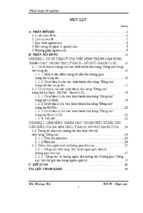BỘ GIÁO DỤC VÀ ĐÀO TẠO
TRƯỜNG ĐẠI HỌC CÔNG NGHỆ ĐỒNG NAI
BÁO CÁO TỔNG KẾT
ĐỀ TÀI NGHIÊN CỨU KHOA HỌC CẤP TRƯỜNG
AN EFFECTIVE WAY TO IMPROVE LISTENING COMPREHENSION
TECHNIQUES FOR SOPHOMORES IN ENGLISH AT NONG LAM
UNIVERSITY
(GIẢI PHÁP HIỆU QUẢ ĐỂ CẢI THIỆN KỸ THUẬT NGHE HIỂU CHO
SINH VIÊN NĂM 2 CHUYÊN ANH TẠI TRƯỜNG ĐẠI HỌC NÔNG
LÂM)
Mã số: TR: 2020-02/NN
Chủ nhiệm đề tài: THS. NGUYỄN VĂN ĐỨC
Đồng Nai, Tháng 5/2021
BỘ GIÁO DỤC VÀ ĐÀO TẠO
TRƯỜNG ĐẠI HỌC CÔNG NGHỆ ĐỒNG NAI
BÁO CÁO TỔNG KẾT
ĐỀ TÀI NGHIÊN CỨU KHOA HỌC CẤP TRƯỜNG
AN EFFECTIVE WAY TO IMPROVE LISTENING COMPREHENSION
TECHNIQUES FOR SOPHOMORES IN ENGLISH AT NONG LAM
UNIVERSITY
(GIẢI PHÁP HIỆU QUẢ ĐỂ CẢI THIỆN KỸ THUẬT NGHE HIỂU CHO
SINH VIÊN NĂM 2 CHUYÊN ANH TẠI TRƯỜNG ĐẠI HỌC NÔNG
LÂM)
Mã số: TR: 2020-02/NN
Chủ nhiệm đề tài
(ký, họ tên)
Đồng Nai, Tháng 5/2021
THÔNG TIN KẾT QUẢ NGHIÊN CỨU
ĐỀ TÀI NGHIÊN CỨU KHOA HỌC CẤP TRƯỜNG
(dùng cho Báo cáo tổng kết đề tài)
1. Thông tin chung:
1. - Tên đề tài: An Effective Way to Improve Listening Comprehension Techniques for
Sophomores in English at Nong Lam University
(Giải pháp hiệu quả để cải thiện kỹ thuật nghe hiểu cho sinh viên năm 2 chuyên Anh
tại trường Đại học Nông Lâm)
- Mã số: TR:2020-02/NN
- Chủ nhiệm đề tài: Nguyễn Văn Đức
Điện thoại: 09855222667
Email:
[email protected]
- Đơn vị quản lý về chuyên môn (Khoa, Tổ bộ môn): Khoa Ngoại Ngữ
- Thời gian thực hiện: tháng 09/2020 đến tháng 01/2021
2. Mục tiêu: Nghiên cứu những khó khăn trong kĩ năng nghe hiểu của sinh viên
chuyên ngữ năm hai ở trường đại học Nông Lâm, nguyên nhân và giải pháp khắc
phục.
3. Nội dung chính: Nội dung tài liệu bao gồm 4 phần chính:
Phần 1: Giới thiệu (lí do chọn đề tài, mục đích nghiên cứu, câu hỏi nghiên cứu)
Phần 2: Tổng quan tình hình nghiên cứu thuộc lĩnh vực đề tài ở trong và ngoài nước
Phần 3: Nội dung nghiên cứu gồm phương pháp nghiên cứu, đối tượng và phạm vi
Phần 4: Kết quả, thảo luận
Phần 5: Kết luận
4. Kết quả chính đạt được: Đề tài đã hoàn thành nội dung như trong tuyết minh ban
đầu.
DANH SÁCH THÀNH VIÊN THAM GIA
STT
HỌ TÊN
ĐƠN VỊ
VAI TRÒ
1
Nguyễn Văn Đức
Khoa Ngoại Ngữ
Chủ nhiệm đề tài
2
Trần Vũ Ngọc Hân
Khoa Ngoại ngữ
Thành viên
3
Trần Vũ Nguyệt Hằng
Khoa Ngoại ngữ
Thành viên
TABLE OF CONTENTS
CHAPTER 1: INTRODUCTION…………………………………………….….……1
1.1. Background of the Study3……………………………………………………..…..1
1.2. Problem statement …………………………………………………………….…..1
1.3. Purpose of the study ……………………………………………………….…...…2
1.4. Research questions…………………………………………………………………………………….………..2
1.5. Significance of the study………………………………………………………………….………………….3
CHAPTER 2: LITERATURE REVIEW
2.1. Overview of listening…………………..…………………………….…………....4
2.1.1. Definition of listening …………………………………………………...……...4
2.1.2. The importance of listening skill………………………………………………...5
2.1.3. Types of listening…………………………………………………………………………………………….6
2.2. Difficulties in learning the listening skill…………………………….……………7
2.2.1.What problems do learners have with listening? ……………………….….…….7
2.2.2 What makes listening so difficult? …………………………………………..……………………….7
2.3. Factors affecting the English listening…………………………………………….8
2.3.1. The class atmosphere…………………… ………………………………………9
2.3.2. Students’ motivation………………………………………….………………….9
2.3.3. Quality of Recorded Material……………………………………………………9
2.3.4. The effect of Accent…………………………………………………………………………………………9
2.4 Solutions to solve problems and also increase listening skill ……………….10
CHAPTER 3: RESEARCH METHODOLOGY
3.1. Context of the study…………………………………………………………..….13
3.2. Participants of the study……………………………………………..…………...13
3.2.1.The teachers ……………………………………………..….…………..…………………………………...13
3.2.2.The students:……………………………………………..….…………..…………………………………...13
3.3. Research tool……………………………………………..….…………..……………………………….…….14
3.4. Data collection procedure……………………………………………..….………14
3.5. Data analysis procedure ………………………………..……………..….………15
CHAPTER 4: RESULTS AND SOLUTIONS
4.1. Results……………………………………………..….…………………….……17
4.2. Solution……………………………………………..….……………..…….……17
CHAPTER 5: CONCLUSION AND RECOMMENDATION.
5.1. Conclusion………………………………..….……………..……………….……20
5.2. Recommendation………………………..….…………..…..……………….……20
REFERENCES ………………………………..….……………..……………………23
APPENDIX 1 ………………………………..….……………..………………..……24
APPENDIX 2 ………………………………..….……………..………………..……26
CHAPTER 1
INTRODUCTION
Nowadays, listening plays a vital role in daily lives. People listen for different purposes
such as entertainment, academic or obtaining necessary information. Of the four language
skills like listening, speaking, reading and writing that all language learners are supposed
to acquire. Listening is believed to be the most challenging due to the complex and subtle
nature of listening comprehension in a second or foreign language. Listening skills
determine 90% of success in all communication, along with speaking skills. And although
listening is a human reflex, but it takes time to learning and practice that we can fluent in
it.
1.1 Background of the study
Listening skill is the most important skill to be successful in all communication. As my
teacher once said with the idea that:” It takes a man three years to learn to speak, but it takes
a lifetime to learn to listen. However, in everyday life, there are very few people who are
able to listen, they accidentally lack an important communication skill and make
communication becomes less effective.
1.2. Problem statement
Most of the students at Nong Lam university studied English for 4 years at school.
However, while learning English I found that they have problems in listening English. So,
the study is design to yield data that would contribute to our understanding of the nature of
problems our students encounter in comprehending English. Through investigating the
listening process, we can learn a great d about how our student approach listening and what
kind of strategies they use.
Besides, the teachers sometimes have to face with difficulties in dealing with the students’
learning demand and newly introduced sources of materials. In addition, teaching methods
and teaching techniques in general, are still below the international standard of education.
Identifying the areas of students’ difficulty at Nong Lam university and the causes of their
unsuccessful listening comprehension is necessary. Therefore, these reasons have inspired
the writing of a study on main causes of difficulties faced by second-year English majors
1
at school as well as some suggested solutions . It is hoped that the study will make some
contributions to improve learning English in general, and listening in particular among the
2nd year English majors at Nong Lam university. The author also hopes that it will be
possible to make useful suggestions for the teachers to improve the situation of teaching
and learning listening.
1.3. Purpose of the study:
The overall aim of this study is to find common difficulties when learning the listening
skills of second-year language major students encountered at Nong Lam university.
Moreover, because of the difficulty, many students are not interesting in learning and
training this skills, so that the study would like to suggest more effective methods for
learnings to help them solve those issues.
1.4. Research questions
1) What are some difficulties of listening to English?
2) Solutions to solve problem and also increase listening skill ?
1.5. Significance of the study
Listening improves your communication skills with people around you. With the listening
process, you can get the problem, gather information, thereby improving the interaction
between you and your partner. Listening helps you to share sympathy with others, and at
the same time you can understand the other person better.
As a researcher, I would like to present the thesis title " An effective way to improve
listening comprehension skills for sophomores in English at Nong Lam university " for
several reasons. First of all, listening and speaking are two major parts of communication.
They are closely interdependent. We are able to talk sensibly when we understand what is
said to us. If we fail to understand spoken language, we may miss important information
and respond in a funny way. Moreover, in learning a language, listening is a useful means
of providing students with comprehensible input, which is an essential component of the
whole language learning process, And leaching listening skill in classroom helps students
make transition from classroom Engsh to real-life English more easily and effectively.
Therefore, I would like to do this research to help the students and teachers pay more
attention to listening skill.
2
Secondly, learning listening skill is the most difficult in learning a foreign language.
Listening, like reading, is a receptive skill but it is often the most daunting for students.
When reading, a reader usually has more opportunities to refer back to the text to carrify
understanding, which a listener can not do in most listening contexts such as TV programs,
meetings, discussion, lectures or conversations.
Last but not least, reason for choosing this thesis title is that many students are not interested
in learning listening skill. They find listening classes boring. On the other hand, practicing
listening skill is difficult and takes long time. That is the reason I would like to work out
some suggestion so as to help teachers motivate their students to study listening skill more
excited and better.
3
CHAPTER 2
LITERATURE REVIEW
2.1. Overview of listening
2.1.1. Definition of listening
Listening is considered as one of the most important skills in acquiring both a
native language and a second or foreign language. It is being paid more and more attention
to. So far, there have been a number of definitions of listening by different linguists such
as Howatt and Dakin (1974); Wolvin and Coakley (1982); Pearson (1983); Hirsch (1986);
Scarcella and Oxford (1992); Bentley and Bacon (1996), Brown (2001), Gary Buck
(2001).
Howatt and Dakin (1974) defined listening as the ability to identify and understand
what others are saying. This involves understanding a speaker’s accent or pronunciation,
his grammar and his vocabulary, and grasping his meaning.
Wolvin and Coakley (1982) regarded listening: “the process of receiving, attending
to and assigning meaning to aural stimuli”.
Pearson (1983) stated “Listening involves the simultaneous organization and
combination of skills in Phonology, Syntax, Semantics, and knowledge of the text
structure, all of which seem to be controlled by the cognitive process. Thus it can be said
that though not fully realized, the listening skill is essential in acquiring language
proficiency”.
Hirsch (1986) gave another definition: “Listening as an aspect of skills: involves
neurological response and interpretations of sounds to understand and to give meaning by
reacting, selecting meaning, remembering, attending, analyzing and including previous
experience”.
Bentley and Bacon (1996) stated that listening, an important part of the second
language learning process has also been defined as an active process during which the
listener constructs meaning from oral input.
4
According to Brown (2001), listening is “not merely the process of unidirectional
receiving of audible symbols”. He supposed that one aspect of listening comprehension
which is “the psychomotor process of receiving sound waves through the ear and
transmitting nerve impulses to the brain”. Hence, listening comprises of three elements: the
sender, the message and the listener.
Gary Buck (2001), for example, points out that “listening comprehension is an
active process of constructing meaning and this is done by applying knowledge to the
incoming sound” in which “a number of different types of knowledge are involved: both
linguistic knowledge and non-linguistic knowledge”.
Scott Shelton (2008) thinks that listening effectively is a demanding and involving
process. One must be able to deal with different accents or pronunciation, unfamiliar
lexical items and syntactic structures, competing background noise, and also make a
conscious effort to not switch off or become distracted while listening. All of this must be
achieved and dealt with more or less simultaneously in order to identify and understand the
meaning in any given message.
To sum up, all of definitions are given with a view to clarifying the nature of the
listening skill which is necessary in the process of acquiring a native language or a foreign
one.
2.1.2. The importance of listening skill
Listening is one of the necessary life skills which are defined as “skills which can
provide you with a better perspective on life, skills which can allow you to maintain a
higher awareness of both yourself and the world around you”. It is one of the most vital
ways that human beings feel the life and live. Everyone, in the real life, often listens more
than speaks, reads or writes. We listen everywhere and every time. We listen to
everything and everybody. For instance, at home, we listen to the news, watch films or
talk with others. At school, students listen to the lecturers teaching. At a meeting, the staff
listens to the new plan from the director, etc. Without listening, the man becomes
backward in each minute of their lives. It is obvious that listening is really important in
the real life.
5
As it is mentioned in the differences between hearing and listening, hearing is a
part of five senses (hearing, smelling, tasting, touching and looking) but listening is a choice
to hear and understand it. As an integrative skill, listening plays an important role in the
process of language learning or acquisition and facilitating the emergence of other language
skill. According to Nord (1980, p.17), listening is the way of learning the
language. “It gives the learner information from which to build up the knowledge
necessary for using the language. When this knowledge is built up, the learner can begin
to speak. The listening-only period is a time of observation and learning, which provides
the basis for the other language skills” (Nation, 1990, p.12). Most learners will spend
more time listening to the foreign language than producing it themselves. Failing to
understand spoken language, people may miss important information presented to them
or respond in a funny way. So training in listening is really necessary. It helps students
make the transition from classroom English to the real-life English more easily and
effectively.
2.1.3. Types of listening
According to some authors, namely Nguyen Thi Van Lam and Ngo Dinh Phuong
(2006), there are two ways of listening in the real life. They are casual listening and
focused listening depending on the purpose of listening.
One type of listening, casual listening, means listening without a particular
purpose. When we listen, we do not pay much or even any attention to the information
unless there is something that interests us. Therefore, we hardly remember the content of
what we hear. Normally, we do this kind of listening when we listen to music, or listen to
news on the radio or TV while doing some housework or chatting to a friend.
Another type of listening is focused listening. That is when we listen for a
particular purpose to find out information we need to know. It happens quite popularly in
the real life. In here, we listen with much more concentration and try to get as much
information as possible. However, we do not listen to every word. We know beforehand
what we are going to listen so we only catch the most important information from the
speech or the lecture. In classroom, learners also use this type of listening
6
2.2. Difficulties in learning the listening skill
2.2.1. What problems do learners have with listening?
According to Alex Case (2019). There are eleven reasons make learners get trouble in
listening in English:
• Learners are trying to understand every words,
• Learners get left behind trying to work out what a previous word meant,
• They just don’t know the most important words,
• Do not recognise the words that they know,
• Have problems with different accents,
• Learners lack listening stamina/ get tired,
• Have a mental block,
• They are distracted by background noise,
• They can’t cope with not having images,
• They have hearing problems,
• They can’t tell the difference between the different voices.
In this study, there are many problems that lead to learners get trouble in listening. The
learners have a habit of understanding all the words in a sentence in order to understand the
content of speaker or unable to understand when the speaker speak spontaneously and it
takes many times to understand.
2.2.2 What makes listening so difficult?
There are eight characteristics of spoken language which makes listening difficult
(Brown, 2001, p.252).
In spoken language, due to memory limitations we break down speech into smaller groups
of words. They are called clustering. For examples: “a lot of”, “a number of”, etc. Therefore
when listening, learners have to learn to pick out manageable clusters of words, avoiding
trying to listen to every word of the speech. It is not necessary and makes learners become
distracted. Moreover, spoken language has a great number of redundancies. They are the
result of rephrasing, repetitions, elaborations and some insertions such as “As I have said”
and so on. At first, learners may get trouble with this. They are easy to be confused.
7
However, with some training learners can take advantage of redundancies to have more
time and extra information.
On the other hand, spoken language also has many reduced forms. It may be
phonological, morphological, syntactic or pragmatic like “you’re” instead of “you are”,
“won’t” instead of “will not”, or “can’t” instead of “cannot”. These reductions are really
significant difficulties to the learners, especially beginners when they start getting to know
the full form of English language.
The next characteristic of spoken language is performance variables. As a result of
unplanned action, spoken language consists of a lot of hesitations (“er”, “uhm”), false starts,
pauses and corrections. They make the listeners confused. Colloquial language is another
problem that can interfere listeners in real life listening because they are familiar with
standard written language. In monologues and dialogues, the appearance of idioms, slang,
reduced forms and shared cultural language are common.
In listening, learners need to comprehend language delivered at varying rates of
speed and delivered with few pauses because they do not have opportunity to stop
speaker and listen again many times.
English is a stress-timed language so it is very important for learners to understand its
prosodic features. By stress, rhythm, and intonation, listeners can interpret more subtle
messages like sarcasm, endearment, insult, solicitation, praise, etc.
The last but not least, interaction is also an element that plays a large role in listening
comprehension. Language learners should be taught the instruction in the two-way nature
of listening. They have to learn to continue the process of comprehending. Some rules of
interaction are negotiation, clarification, attending signals, turn-taking, topic nomination,
maintenance, and termination.
In short, it is necessary for language learners to understand all of these characteristics of
spoken language in order that they get more ease in interaction in general and in listening
in particular.
2.3. Factors affecting the English listening
8
2.3.1. The class atmosphere
Sometimes inconvenience of classrooms affects students listening comprehension. In the
large classrooms students who are sitting on the back rows may not hear the recording as
students sit in front. Students who prefer to stay next to the windows also effected by the
noise that come from outside.
2.3.2. Students’ motivation
Students’
motivation
is
one
of
the
crucial
factors
that
affect
listening
comprehension. It can be difficult for students maintaining the concentration in a foreign
language learning classroom. In listening comprehension, even the smallest pause in
attention may considerably spoil comprehension. When students find the topic of the
listening text interesting, comprehending would be easier. For all that, students find
listening very boring even if they are interested in the topic because it needs a huge amount
of effort in order to not miss the meaning.
2.3.3. Quality of Recorded Material
In some classes, teachers use some recorded materials that do not have high quality.
The quality of sound system can impact the comprehending of learners’ listening.
2.3.4. The effect of Accent
Munro and Derwing (1999) expressed that too many accented speech can lead to an
important reduction in comprehension. According to Goh (1999), 66% of learners
mentioned a speaker’s accent as one of the most significant factors that affect listener
comprehension. Unfamiliar accents both native and non-native can cause serious problems
in listening comprehension and familiarity with an accent helps learners’ listening
comprehension. Buck (2001) indicated that when listeners hear an unfamiliar accent such
as Indian English for the first time after studying only American English will encounter
critical difficulties in listening. This will certainly interrupt the whole listening
comprehension process and at the same time an unfamiliar accent makes comprehension
process and at the same time an unfamiliar accent makes comprehension impossible for the
listeners.
Some other failures affecting the listening comprehension are external to the
communication. As Thailand is a monolingual country where English is not used in
9
everyday life, most Thai students lack exposure to English spoken by native speakers
(Kongsom, 2009; Wiriyachitra, n.d.). This is an important external factor causing Thai
students to lack listening skills. Another important factor can be the backwash effect
from the university entrance examination. Since listening is not included in the entrance
examination, this skill is rarely seriously taught, particularly in primary and secondary
school levels (Matsumoto, 2008).
2.4 Solutions to solve problems and also increase listening skill ?
• Improve the teaching methods of the lecturers
Teachers need to better their skill or pronunciation because some of them still get troubles
in speaking, that leads to students get problems in listening.
• Upgrading facilities and equipment in listening
There are lots of school that has not had the modern facilities so that it is hard to have a
listening exam. For example, if you have an exam but your school still use a cassette in
2000s, you will mad and it is difficult to have a high score.
For those of you who prefer to study English alone, here are some tips to get better at
listening.
• Study a little bit at a time.
Only have a few minutes per day to study? Perfect. Believe it or not, that’s even better than
having a lot of time to study.
I recently discovered that my favorite learning method, studying around 15-20 minutes a
day instead of a few hours in one sitting, actually has a name: microlearning.
• Listen to the same English podcast every day for a week.
Find a podcast that you find interesting or entertaining and choose one episode. Listen to
that episode every day for a week—while you’re driving, riding the bus, washing dishes,
etc. Pick out words or phrases that are difficult to understand and look them up on the first
and second days. Don’t forget to hit “pause” and listen again.
• Overhear an English conversation.
If you’re living somewhere where English is spoken, take an afternoon to hunt for an English
conversation. When you start to hear English, slow down and listen. At first, you won’t
10
know what they’re talking about since you’ll probably start listening in the middle of the
conversation. This will make it even more challenging to understand, but also more fun.
Listen for any new words you may not know, and also try to see if you can catch what the
conversation is about. You can search for English conversation on a bus, in a cafe or at a
park—but hopefully not a movie theater!
• Read and listen at the same time.
Another way to improve your listening skills is to use two sources of information at the
same time.
This simply means that you should be not only listening, but also getting your English from
another place at the same time.
The easiest way to do this is by watching an English video with English subtitles. This way,
you’ll be listening to and reading the words, which will make it easier to understand
everything and will help you to remember more.
• Experiment with different accents.
Are American movies easier for you to understand than British movies? Or maybe the
opposite is true? You might have trouble understanding some English accents the first few
times you listen to them.This is normal! Even native English speakers can have trouble
understanding different English accents.
But all English accents are beautiful, and you can understand them all if you just keep on
listening.
• Prepare your conversations before they happen.
Conversations are all about speaking, but this is a post about listening skills, so why am I
including this here?
Easy, every conversation, even those with ourselves, include a speaker and a listener.
Now, I know this trick works because I use it myself. Let me give you a little bit of
background.
• Join a conversation group.
After all this practice alone, you’re ready to start actually using your new listening skills.
11
One great way is to join a group of English learners who host a conversation table.
Conversation groups usually meet regularly, but it’s not a class. You don’t have to come
every week; the purpose is simply to converse (talk) in English. Meetup is a great place to
look for English conversation groups. If you can’t find a group near you, start your own.
12
CHAPTER 3
RESEARCH METHODOLOGY
3.1 Context of the study
The study was conducted at Nong Lam University. Therefore, the faculty of Foreign
Languages must be proactive in organizing English classes at different levels, collecting,
selecting and compiling appropriate learning materials and curriculum to meet the training
goals create. The differences between Nong Lam Faculty of Foreign Languages and other
schools are: The training program includes courses to improve language practice skills,
knowledge of language theory such as Phonology, Semantics, Grammar, knowledge of
English-American culture and literature.
3.2 Participants of the study
The survey participants are all second-year students and teachers of the faculty of Foreign
Languages who is responsible for designing training programs and teaching classes for
language hustudents.
3.2.1. The teachers:
The survey of all Teacher of The Faculty of Foreign Languages consists of 31 Teachers at
Nông Lâm University. Their ages from 26 to 52. Majority of them graduated from the
faculty of foreign languages of Education University Ho Chi Minh or University of Social
Sciences and Humanities. The questionnaire was asked all English teachers who have
average 4-17 years' experience in teaching English. They are all professionally experienced
with English foreign language.
3.2.2. The students:
The research was undertaken with the participation of 52 second-year students in Faculty
of Foreign Language. They age from 20 to 21. A large numbers of them have earnt English
for 7 years ( 4 years at secondary school and 3 years at high school). However, their English
backgrounds are quite similar because most of them come from different rural areas in the
North and under being influence of curriculum of English for high schools students in the
past, students did not have many chances to practice English skills.
13
3.3 Research tool
To improve the quality of information, it is expedient that data is collected so that we can
draw inferences and make informed decisions on what is considered factual. The instrument
is survey questionares.
The questionares were designed both for students and teachers because the research finds
them easy to summarize and analyze the collected data. We made a questionaire from three
to five level depent on the importance of the information of the question was devided into
two parts. At first part was aim to asking of the frequency about Student’s learning style
with 4 options for each question and the last one is the most important that realated to the
difficuties of student when listening English including 7 questions with 3 main problems:
(1) Problems from the listeners to identify problems, students are asked to put their answer
on as scale of frequency ranging from never to always. Problems are classified into two
different categories, namely problems from the listeners and listening materials and
equipment.
(2) Problems from the listening material
(3) Problems result from physical settings. Not only the difficulties come from the message,
the listener or the speaker but also come from the environment surrounding the students.
3.4 Data collection procedure
When the data collection was accomplished, the data analysis was initiated. The results of
survey questionares revealed students’ techniques they use in listening skill. The participants
were asked to fill out the close-ended questionnaire within 10 to 15 minutes. Hence,
Microsoft Excel 2013 was conducted for data analysis. For each measure, percentage was
used to determine the overall patterns of the sophomores’ English listening difficulties and
speaking strategy uses.
To analyze the sophomores’ difficulties in listening English, the analysis focused on the
items that were arranged in increasing order of frequency as “ Never”, “Sometimes”,
“Often”, “ Always” “ Once”, “Twice”, “ Three times”, “” more than three” “ Rarely” focused
on Student’s learning style and problem sophomores encounter when listening English. We
14





















